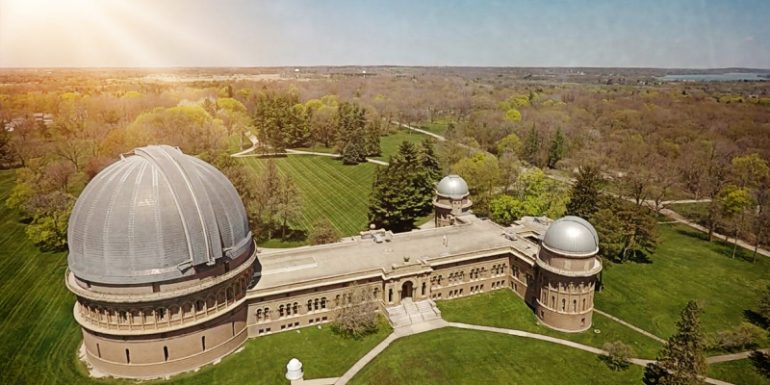Photo courtesy of Yerkes Future Foundation
Director Dennis Kois and the team at Yerkes Observatory, announced that the internationally famous site in Williams Bay will re-open for public tours beginning Friday, May 27th, following the successful completion of the first phase of a multimillion-dollar restoration and upgrade project. The Observatory was built in 1895 by the University of Chicago as an extension of its newly formed department of astrophysics and remained under its stewardship until May of 2020, when the University sold the building, its contents and 50 acres of adjacent land to the nonprofit Yerkes Future Foundation. Since then, Kois says the Foundation has undertaken a massive restoration of the 125-year-old structure and grounds.
One of the first steps involved drying out and resealing the building’s brick and stone exteriors, which Kois says had “absorbed thousands and thousands of gallons of water over the years.” To accomplish this huge feat, the Foundation engaged Chicago-based Marion Restoration, a company that claims among its many projects the restoration of Chicago’s Graceland Cemetery, the United States Courthouse and Federal Building in Milwaukee and the McHenry County Courthouse in Woodstock.
Other projects that the Foundation has tackled at Yerkes Observatory in this first phase include the cleaning and restoration of the building’s artisan interiors, including intricately tiled floors and thousands of square feet of Carrara marble. Additionally, librarian Judy Bausch has undertaken the sorting and organization of the building’s priceless science library, which includes 180,000 glass plate negatives taken by the Observatory’s telescopes over the years, which will remain in the University’s collection, administered by the Yerkes Future Foundation.
Upgrades to maximize visitor experience include the addition of a 50-car parking lot on the east side of the building with charging stations for electric vehicles, charged by 83 solar panels installed on the building’s roof. Kois says that visitor restroom updates are currently under way and will be completed before tours can resume. He says that everyone at the Foundation is excited to welcome the public back to see the progress that has been made. “This building is such a symbolic component of the landscape,” he explains. “The full renovation will take many years, but we have the foremost experts in their fields working on it.”
Tours of the Observatory will give a behind-the-scenes look at the restoration work currently under way, while highlighting the stunning exterior and interior details that have made Yerkes Observatory architecturally significant for more than 100 years. The building is widely considered the most architecturally beautiful observatory in the world, in addition to being revered as the site where a rotating roster of brilliant astronomers worked together between the 1890s and the 1980s: George Ellery Hale, E.E. Barnard, Mary Calvert, Edwin Hubble, Otto Struve, William Morgan, Nancy Grace Roman, Gerard Kuiper, Carl Sagan, Subrahmanyan Chandrasekhar, Richard Kron and many more. On his first visit to America in 1921, Albert Einstein famously named the Observatory as a “must-see” location.
Famous landscape designer Frederick Law Olmsted’s firm originally designed the 50 acres of grounds that once surrounded the Observatory. Yerkes staff have been working for two years to restore the remaining grounds to the Olmsted 1906 plan and are laboring to add their own botanical touches making use of modern ecological research. Yerkes Observatory’s grounds have been recognized as part of the nationwide “Olmsted 200” celebration taking place this year. Madisoh landscape design firm Parkitecture is currently creating five miles of trails throughout the 50 acres of woods, lawns, and gardens that rise from the shores of Geneva Lake. The Foundation has installed 83 solar panels on the roof which will power much of the Observatory, as well as its two new EV chargers in the new, dark-skies-compliant parking lot. In addition to this, there are new welcome gardens, pollinator gardens and a future apiary.
Tour tickets must be reserved on Yerkes Observatory’s website. All proceeds go to the preservation and restoration of this international landmark of science, architecture, and landscape design. Visitors must pre-purchase tickets to park in the Observatory lot on Thursdays through Mondays, but visitors are free to stroll the 50 acres if they walk in from off-site during tour hours, 9:30 a.m. to 5:30 p.m. on those days. The Observatory will be closed on Tuesdays and Wednesdays. For more information, visit yerkesobservatory.org.





